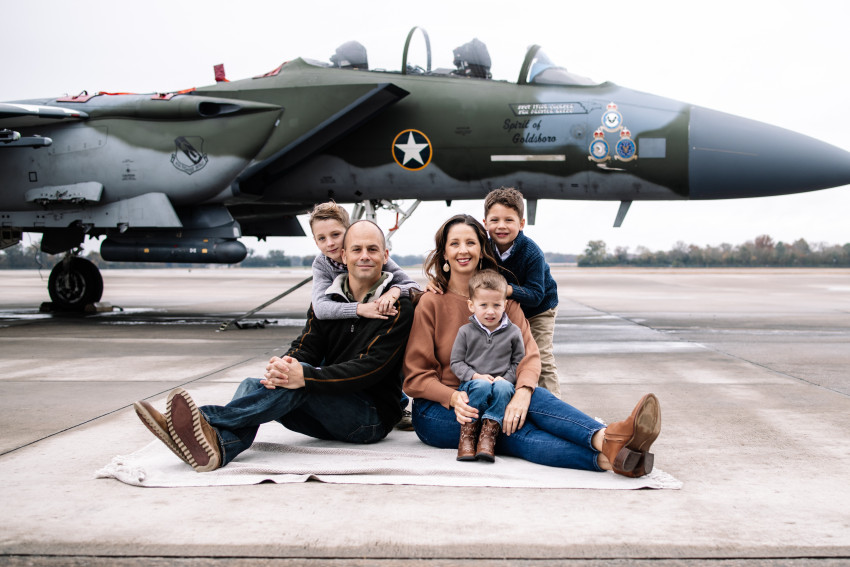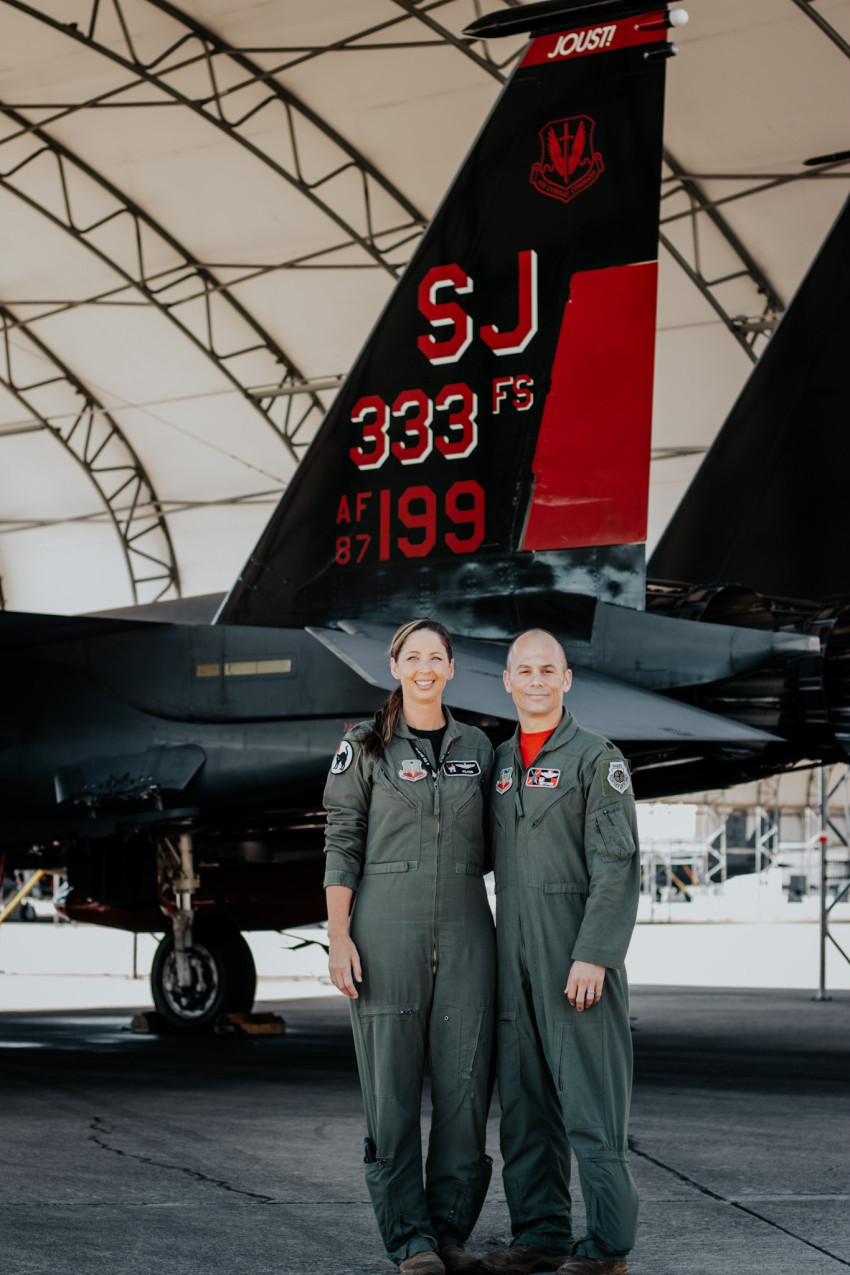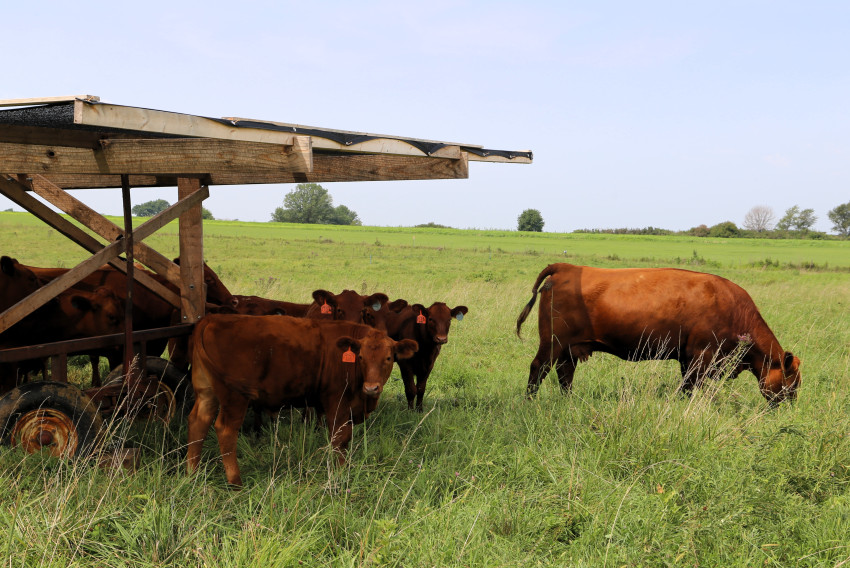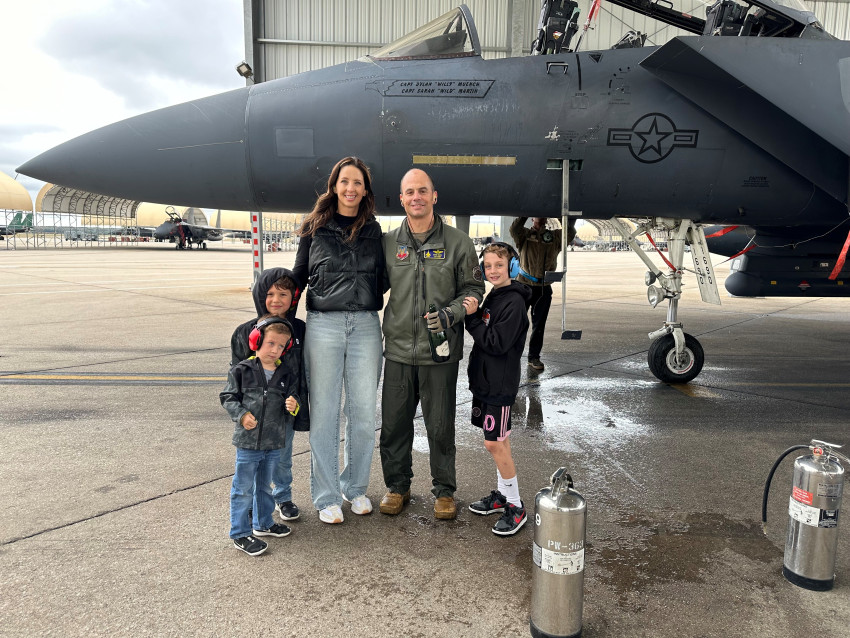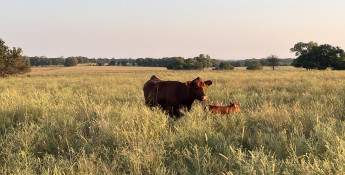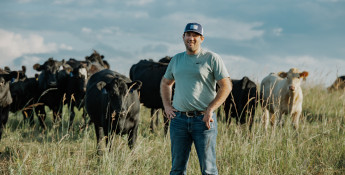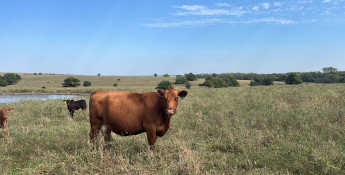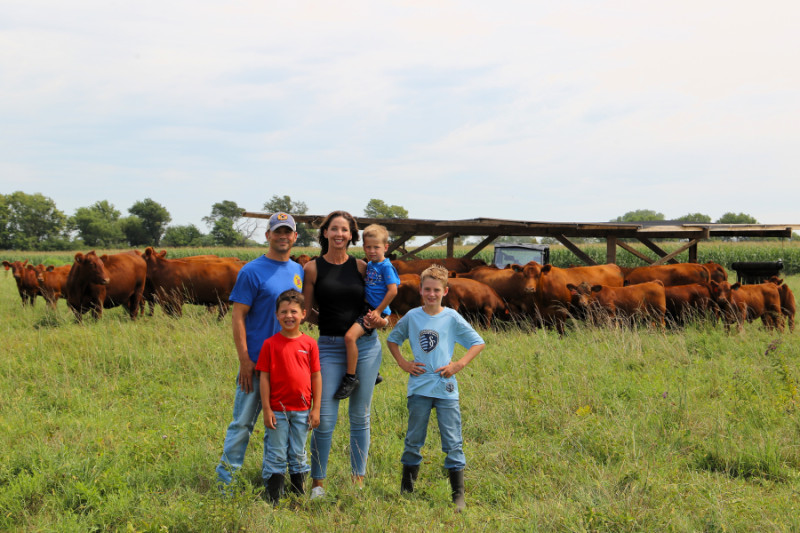By Greg Doering on November 4, 2025
Air Force Flyers Jet for New Ranch Life in Kansas
Retired Air Force veterans start regenerative ranch in eastern Kansas
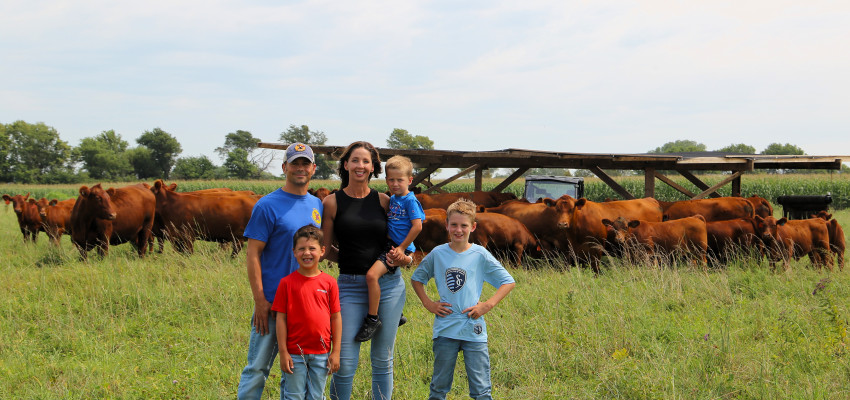
Childhood dreams generally take people away from home, but Drew Bures’ dream to fly jets just like Maverick in “Top Gun,” has allowed him the opportunity to return to the same place he watched the movie countless times while growing up in northern Anderson County.
While Bures didn’t fly for the Navy like Tom Cruise’s character did in the movie, he spent 20 years piloting F-15Es in the Air Force. After achieving his Air Force goals, Bures retired earlier this year as a lieutenant colonel to start working on a different dream.
“I just looked at my three boys and wanted them to grow up and have the childhood I did,” he said. “This farm has been in the family for three generations, and we’re the fourth. Wanting to keep it in the family was something that is very important to me.”
He and his wife, Krista, have started Blue Skies Regenerative Farms. Krista grew up on a farm in Utah before joining the Air Force and served as a weapons systems officer on F-15Es where she managed the aircraft’s sensors, weapons and overall mission execution.
“One of the most appealing things about coming back to the farm was purpose and autonomy,” he says. “Being the fourth generation, to work outside and stay active in retirement provided that purpose. The autonomy of being self employed is second to none.”
Drew says he decided to leave the Air Force after completing his command of the 333rd Fighter Squadron. “In my opinion, squadron command was the best job in the Air Force, so I wanted to go out on a high,” he explained. In the end, he found himself increasingly more interested in returning to the family farm and working in his backyard garden.
“We had a little garden behind our house,” he says. “I would still be in my flight suit in the North Carolina summer and be in the garden for 30 minutes to an hour before even going in the house because I enjoyed it.”
PUTTING DOWN ROOTS
Drew and Krista were in different squadrons but were both assigned to an airbase in North Carolina when they met. They were also stationed at Lakenheath, England, the Air Force Academy in Colorado Springs, Colo., and ended their careers back in North Carolina.
“We’re happy to actually grow roots and make connections with neighbors,” Drew says of retiring and moving home. “When you’re living in one place for three years, you don’t make the effort to really get to know your neighbors like we have here.”
The move has also made it easier for their children, Luke, Ben and Noah, to experience some normal rites of passage of childhood, like having family at sporting events.
“Ben was at a soccer game in North Carolina and he came over and said, ‘My friend has 12 people here for him,’” Krista says, noting he wasn’t old enough to understand some families live close enough to attend games. “When we came back, he got to play baseball with cousins, uncles and grandma in the crowd.”
In addition to closer connections to family, Drew is excited at the prospect of the boys having free access to the great outdoors.
“We haven’t gotten into hunting yet, but they want to go fishing twice a day every day,” he says. “That’s a little much.”
STARTING SMALL
Drew grew up on a diversified farm with both crops and Limousin cattle, but his dad sold the cattle herd about five years before he returned. He initially explored picking up where his dad left off before settling on restarting the herd with red Angus, to target the market premium that Angus offers, but going red for the heat tolerance the red cattle have compared to black Angus.
“We started with 20 (cow-calf) pairs on about 45 acres, which is close to double the normal stocking rate,” Drew says. “I knew we were going to be small, so we’ve worked to find a way to maximize the profit from a small acreage.”
Rotational grazing has allowed him to put more cattle on smaller pastures. Instead of grazing the herd over the entire 45 acres, Drew confines them to only an acre or two each day. Because cattle can be picky about what they eat, the smaller parcel forces them to consume all the available forage rather than selectively grazing just the desirable grasses and forbs.
It's a method he settled on after hours of research led him to believe his focus didn’t necessarily need to be on producing the best cattle, rather if he took care of the grass and soil, the cattle would take care of themselves.
This patch grazing increases the total forage produced by a pasture because it’s essentially like mowing your lawn. The grass will stop growing at some point if it’s not cut, but with regular clippings and enough rain, it will grow from early spring to late fall.
The method also allows the pasture to rest between grazing periods, depending on the season. In the spring, cattle were turned out on each paddock on a 21-day cycle, which was increased to 35 days in the heart of summer when hot, dry days slow overall forage production.
“Every move is to fresh grass that looks like spring turnout,” Drew says. “The cows act like spring turnout because they’re so excited to see the fresh forage.”
TIME AS A STRENGTH
With a small herd and access to two military retirement plans, time is a strength on the ranch, and what allows Drew and Krista to experiment with a nontraditional grazing system.
“We aren’t bound by the way it’s always been done because we’ve never done it,” Drew says. “I did the work growing up, but I wasn’t the decision maker. I could drive the tractor and do the technical things, but I didn’t know anything about operational management.”
While the grazing plan they’ve employed maximized the forage produced by pastures, the tradeoff is it requires significantly more time than traditional pasturing of cattle. It’s not just moving the animals — it’s also ensuring the next paddock has water access and shade. While stream access has provided much of the water for the Bureses’ small herd so far, they’ve also rehabbed an old well on the property.
Additionally, Drew repurposed the chassis of an old hay wagon into a mobile shade structure to provide cover in the middle of a pasture where manure will be returned to the grass rather than in less productive land under tree canopies.
He intends to continue the concept through the winter by patch grazing hay meadows after the first frost and supplementing hay as needed. The idea is to return as many nutrients as possible to the hayfields while decreasing or eliminating the need for synthetic fertilizers.
“People say it only takes 10 minutes to move the cattle,” Drew says. “I give it a solid hour by the time you drive out, roll up one fence and roll out the next one.”
But like the garden in North Carolina, the daily trips to the pasture are one of the highlights of the day for Drew.
“I look forward to it,” he says. “That’s what gets me out of bed. I wish I could stay out there longer. It’s the other stuff — changing a flat tire, changing a bearing on the baler or the other maintenance that can be a chore.”
GROWTH PLAN
After nearly two decades in the Air Force, both Drew and Krista are accustomed to planning and accounting for contingencies. One big difference is the stakes at Blue Skies are different than trying to guess how much force an adversary could commit to defending their airspace.
“We have a plan, but Mother Nature gets a vote as well,” Drew says. “When our plan is met with reality, we have to stay flexible and adjust.”
After a handful of moves, retirement and starting a new business, they’re familiar with navigating life flexibly. They’re also building a house about 10 miles away from the farm, which brings its own opportunities and some new challenges.
Drew wants to nearly double the herd in year two, and the 100-plus acres at the new home site will make it possible, but the split herd will require more travel time between the two locations.
“I may change from a daily rotation to every two so I’m only moving one bunch every day,” he says. “But then that’s also the most enjoyable part of my day.”
He sees the herd topping out around in year three with about 60 cow-calf pairs, maybe a few more. He also knows he’s starting a herd at an expensive time, with cattle setting records after prolonged drought has reduced the U.S. cattle herd to its smallest since 1951.
“I don’t know if there’s a better time to get in,” Drew says. “There’s risk, of course, but I’m optimistic that prices are going to stay high during our growth period.”
Krista says their time in the Air Force also provides flexibility as they start their new venture.
“We’re incredibly lucky because we have two retirements that we get immediately and we have nothing but time to experiment and try new practices,” she says. “That’s a huge privilege that comes with a career in the military.”
‘LIKE A VACATION’
For now, the shift from military to civilian life has been pretty seamless as the family adjusts to their new reality.
“It’s a blessing and a curse that our house isn’t ready,” Krista says. “If we were there, we’d be working on that the whole time, but now we’re just focused on cows and kids. It’s nice, it’s like vacation.”
In the sequel to “Top Gun,” Tom Cruise’s character appears to have come to grips with the end of his career as a Navy pilot, but the final scene shows him flying in a P-51 Mustang with Penny, his love interest in the movie.
“I wish instead of Maverick having his own P-51, he had a small herd of beef cattle,” Drew says. “But I still enjoyed the movie.”
It’s also possible the dream hasn’t ended, rather its location has merely shifted from under the glass of a F-15E to the lush grass of eastern Kansas. There’s still plenty of blue sky to explore as a family.
To learn more, visit www.instagram.com/blue_skies_regenerative_farms/

